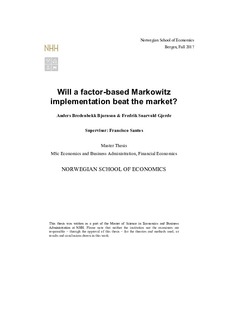Will a factor-based Markowitz implementation beat the market?
Abstract
In this thesis, we look at whether a factor-based implementation of the Markowitz (1952) framework
beats the market. Different sets of factors are used in the framework, to see whether this
choice affects the results. We find the optimal portfolio by using past data to invest in the future.
This is implemented, with annual rebalancing, on US stock data from 1964 to 2016. Portfolios
are formed on daily, weekly and monthly data to see whether the frequency of the return
measurement gives different results.
Our framework begins by running factor regressions on each stock. These coefficients are used
in combination with the expected returns and the covariance matrix of the factors to calculate
the expected returns and covariance matrix of the stocks. Performance is evaluated by looking
at the mean one/four-year ex-post Sharpe- and appraisal ratios, as well as the crash-risk of our
portfolios.
Based upon the mean one-year Sharpe ratios, our factor-based portfolios formed on daily data
all significantly beat the market, while there is no such significance for the portfolios formed
on weekly or monthly data. However, all of our factor-based portfolios have a statistically
significant one/four-year appraisal ratio when using the market as our benchmark. We also find
that there does not seem to be a higher crash-risk for our portfolios than the market.
Our portfolios, when formed on the same measurement frequency, perform remarkably similar.
This shows that our framework is an approximation of the standard Markowitz (1952) theory,
rather than a factor-based investment strategy. The only thing not accounted for in our framework
is the stock covariance explained by the residuals left in the regressions. We also find that
this is a more stable implementation of the Markowitz theory, avoiding non-positive definite
covariance matrices.
